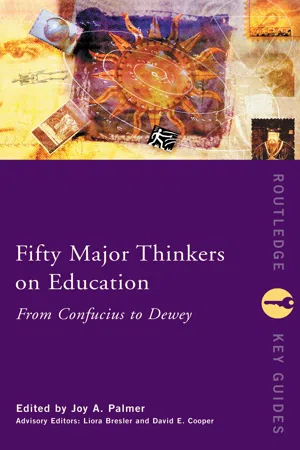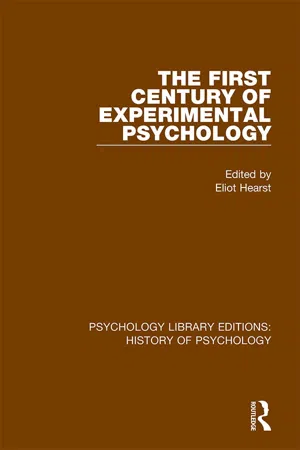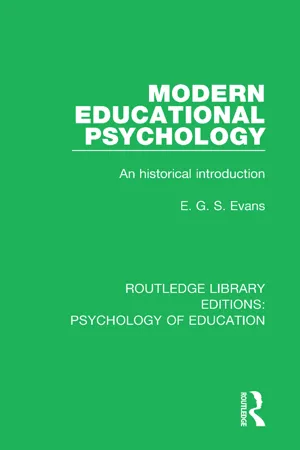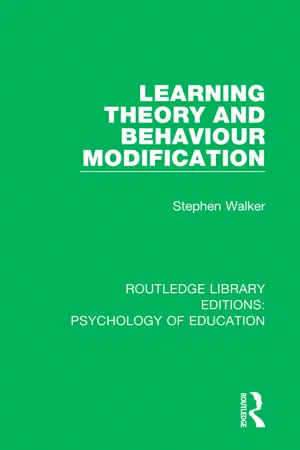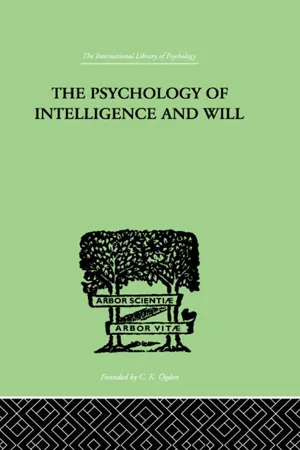Psychology
Edward Thorndike
Edward Thorndike was an influential psychologist known for his work in the field of behaviorism and learning theory. He is best known for his theory of "law of effect," which states that behaviors followed by positive consequences are more likely to be repeated, while behaviors followed by negative consequences are less likely to be repeated. Thorndike's research laid the foundation for the study of operant conditioning and animal behavior.
Written by Perlego with AI-assistance
8 Key excerpts on "Edward Thorndike"
Learn about this page
Index pages curate the most relevant extracts from our library of academic textbooks. They’ve been created using an in-house natural language model (NLM), each adding context and meaning to key research topics.
- eBook - ePub
Personality Theories
Critical Perspectives
- Albert Ellis, Mike Abrams, Lidia Dengelegi Abrams(Authors)
- 2008(Publication Date)
- SAGE Publications, Inc(Publisher)
While behaviorism was in its infancy, there were psychologists in the German universities working along parallel lines. These psychologists studied the mind in a distinctly different fashion from either Pavlov or the structuralists. The predominantly European school of Gestalt psychology explored the means by which the human psyche creates forms that are inherently processed as a whole. The Gestalt school, like the behaviorists, set forth ideas that were in direct contradiction to those of the structuralist psychologists, who attempted to analyze consciousness and reduce it to its molecular components. The Gestalt psychologists’ research showed that the human mind constructs a reality that is greater than or different from the sum of the parts of conscious experience.EDWARD L. THORNDIKE
Edward L. Thorndike, an educational psychologist who spent almost all of his career at Teachers College of Columbia University, was an early proponent of what would become behaviorism. Thorndike believed that the results of studying animal learning and thought can be applied to gaining a better understanding of human learning and behavior. This idea was not at all acceptable to the structuralists, the psychologists who dominated the study of psychology in the United States when Thorndike was in graduate school. The structuralists studied human consciousness exclusively.Thorndike anticipated some key elements of behaviorism, with the exception that he allowed for species-specific behaviors and individual differences among humans. Such reservations would become anathema to the more strict behavioral theorists. Thorndike’s role in establishing the basis for animal models of human behavior was nonetheless critically important. He proposed that humans do not differ qualitatively from other animals but do differ in the quantity and complexity of associations acquired by their brains. He was instrumental in helping define psychology as a separate science rather than a branch of philosophy. He emphasized that psychology must be based on standard scientific procedures, like those used by the physical sciences.Image 10.2 Edward L. Thorndike (1874–1939)The Law of Effect
Thorndike proposed this law of learning, called thelaw of effect - eBook - ePub
Fifty Major Thinkers on Education
From Confucius to Dewey
- Joy Palmer, Liora Bresler, David Cooper, Joy Palmer, Liora Bresler, David Cooper(Authors)
- 2002(Publication Date)
- Routledge(Publisher)
E.L. THORNDIKE 1874–1949
Education is concerned with changes in human beings; a change is a difference between two conditions; each of these conditions is known to us only by the products produced by it — things made, words spoken, acts performed, and the like. To measure any of these products means to define its amount in some way so that competent persons will know how large it is, better than they would without measurement.1Edward Lee Thorndike is perhaps the most influential of all American psychologists. His early work in animal learning helped establish comparative psychology as an experimental science and created the field of psychology that became known as the experimental analysis of behaviour. He introduced important methodological innovations to behavioural science. He laid the methodological and philosophical foundation of the behavioural psychology of John B. Watson and B.F. Skinner. He applied principles of learning developed in the laboratory and quantitative measurement of individual differences to create educational psychology. He produced 507 publications, over 50 of which are books.2 As a measure of his influence, Tolman observed in 1938 that the psychology of learning, both animal learning and human learning, was largely a matter of agreeing or disagreeing with Thorndike.3 Psychology has moved on, but Thorndike’s influence is still felt to day, the result of his impact on the historical development of both psychology and education.Thorndike was born in Williamsburg, Massachusetts on 31 August 1874. He was the second of four children, all of whom had academic careers and three, including Edward Lee, becoming professors at Columbia University.4 His father, Edward Roberts Thorndike, was trained in the law and later became a clergyman; his mother, Abigail Brewster Ladd, was a home-maker.5 - eBook - ePub
- Elliot Hearst, Eliot Hearst(Authors)
- 2019(Publication Date)
- Routledge(Publisher)
The change that Thorndike injected into the concept of associationism concerned the nature of the association: It was not ideas that animals associated, it was movements (R) in a given situation (S) that led to satisfying consequences. Thorndike spoke of neuronal connections in the brain and hypothesized that the synaptic links between them were gradually made more traversible by use and by satisfactory consequences, whereas disuse or annoying consequences made the neuronal connections underlying other S-R associations less traversible. This was Thorndike’s neurological account of trial-and-error learning, later to be reintroduced and expanded in a significant way by Donald O. Hebb (1949).The foregoing represents Thorndike’s bequest to what has today become “general behavior theory,” or as stated more precisely and modestly by H. M. Jenkins (Chapter 5 , this volume), the study of the nature of the associations formed during conditioning.Thorndike also made three influential contributions to comparative psychology:1. By the introduction of the puzzle box and other standard testing situations, and the careful quantification of his observations, he set the comparative psychology of learning on an objective course from which it has since rarely deviated. Thorndike also incidentally helped pave the way for the methodological and theoretical behaviorism of John B. Watson a decade later, but it is clear that a number of other significant intellectual threads were also tending in that same direction around (and even before) the turn of the century: Sechenov’s “reflexes of the brain” (1863), Ivan Pavlov’s highly quantitative conditioning procedures (Yerkes & Morgulis, 1909), Jacques Loeb’s (1912) physicochemical reductionism and his tropistic theory of psychology, and especially H. S. Jennings’ (1906) objective experimental approach to behavioral adaptation in single-celled paramecia, among other protozoan and lower metazoan organisms. In fact, with Watson’s writing of Behavior: An Introduction to Comparative Psychology (1914) and Psychology from the Standpoint of a Behaviorist (1919), virtually all of general psychology became objective in methodology. Psychology became the study of behavior (instead of the mind), with the conditioned response (reflex) as its primary unit of analysis and conditioning as its tool. Ironically, that turn of events largely buried the distinctive feature of comparative psychology: It ignored the notion of the evolution of a psychological scale or grades of adaptation, even though one of Watson’s biological mentors clearly stated that central physiological mechanisms are - George E. Stelmach(Author)
- 2014(Publication Date)
- Academic Press(Publisher)
Watson (1913) and his behaviorism. Watson was more interested in Pavlovian conditioning than in the instrumental learning that fascinated Thorndike, and Thorndike was not an evangelist for behaviorism like Watson, but the two were allies in rejecting the mentalism of the past and in asserting objectivism in psychology. These two major figures in our history gave American psychology a strong interest in learning, and their mutual concern with objectivism got learning off to a hard-headed start.Thorndike’s (1898) doctoral dissertation is famous, and it is worth reading today. There were various studies in it, but typical and influential ones were with a puzzle box. He placed a cat on the inside of a slatted box from which it could see outside. Food was put on the outside, and the pull of a wire loop on the inside opened the door and made the food available as reward. The solution times were long on the early trials, but as the rewarded trials continued the response times became shorter and shorter until the response was swift and sure. This approach to learning was objective, quantitative, and reliable; it met basic criteria of science.Thorndike’s interest in animal research lasted only a few years, but during that time the mysteries of adaptation through instrumental learning became clear to him. Out of all of the responses that can be made in a situation, how does an organism adjust? How are adaptive responses strengthened and maladaptive responses weakened? The answer was selective learning and the law of effect. Selective learning is what Thorndike (1913) called “multiple response to the same external situation [p. 12 ].” An early statement (Thorndike, 1907 ) of the law of effect was… that any act which in a given situation produces satisfaction becomes associated with that situation, so that when the situation recurs the act is more likely than before to recur also. Conversely, any act which in a given situation produces discomfort becomes dissociated from that situation, so that when the situation recurs the act is less likely than before to recur [p. 203 ].The aftereffects of a response class affect the probability of future responses in the situation; they select one response class out of many in the situation and change it. Thorndike advocated associationism, not between ideas, as in an earlier day, but between stimulus and response, and a hedonism with the emphasis on pleasure and pain.- eBook - ePub
Modern Educational Psychology
An Historical Introduction
- E.G.S. Evans(Author)
- 2017(Publication Date)
- Routledge(Publisher)
Of immense importance also at the turn of the century were Thorndike’s animal studies of ‘trial-and-error’ learning and (in conjunction with R. S. Woodworth) his experiments on the problem of the transfer of training. The principal conclusion that Thorndike drew from his animal studies was that learning depended not on insight or understanding but on random, trial-and-error activities in the course of which the correct actions or responses appeared, albeit fortuitously, but which, through repeated practice became progressively ‘stamped in’, that is, learned, by their own satisfying consequences. For Thorndike the functional units in learning were what he called bonds or connections, arbitrarily established between stimuli and responses and which, through exercise and reward, became strengthened and organized into complex systems of behaviour.The results of Thorndike’s animal studies were expressed in his famous laws of learning which were natural developments of the traditional principles of association and were called (1) the law of exercise or habit-formation, and (2) the law of effect. The law of exercise, under which were included the old associationist ideas of frequency, recency and intensity, stated that bonds or connections between stimuli and responses were strengthened by use and weakened by disuse. The law of effect was merely a restatement of the principle of psychological hedonism and held that successful or satisfying responses led to a strengthening of learning bonds, while conversely, unsatisfying or annoying responses resulted in failure and a tendency for the bonds to be weakened and rendered less likely to appear again in the future. - eBook - ePub
- Stephen Walker(Author)
- 2017(Publication Date)
- Routledge(Publisher)
8Applications of stimulus-response theories from Thorndike to Wolpe
Thorndike's first experiments were designed to prove that cats and dogs act by conditioned impulses, rather than by using memory or anticipation (1898; pp. 7–10 above). In his next monograph (1901), Thorndike went on to claim that this was also true of monkeys: ‘In their method of learning, the monkeys do not advance far beyond the generalized mammalian type.’ To Thorndike's eye, there was no evidence of imitation, accurate discrimination, or memory in the behaviour of monkeys; they simply formed associations faster than other mammals. One might go on from this assumption to deduce that human learning must take an entirely different course. But already, in 1898, Thorndike was saying about his principle of stimulus-response connections that ‘this hitherto unsuspected law of animal mind may prevail in human mind to an extent hitherto unknown’ (Thorndike, 1898, p. 105). In fact, soon after doing his first work with animals, Thorndike became professor of educational psychology at the Teachers College of Columbia University and concerned himself mainly with human abilities. But this closer contact with research on human beings did not make him change his mind – in 1931 he still felt that the stimulus-response principle could be applied to human activities, and in his book Human Learning (1931) he said ‘the situation-response formula is adequate to cover learning of any sort, whether it comes with ideas or without, conscious or unconscious, impulsive or deliberate, by Gestalten or even by a miracle’ (p. 132).Many students are still familiar with one of Thorndike's particular contributions to education, which may be used to illustrate both the virtues and vices of his general approach. Perhaps Thorndike's most frequently read publication is The Teacher's Word Book of 20,000 Words, expanded to include 30,000 words (Thorndike and Lorge, 1944). If language is composed of word habits, and habits are accumulations of practice, then it is useful to know exactly how often any given word is used. The first two chapters of Thorndike's Human Learning - eBook - ePub
- Wyatt, H G(Authors)
- 2013(Publication Date)
- Routledge(Publisher)
CHAPTER VI THORNDIKE ON INTELLIGENCEI. The Nature of IntelligencePROFESSOR Thorndike, so far at least as his theoretical principles are concerned, is a leading exponent of the reaction-hypothesis or ‘stimulus-response’ school of psychology. Now as has been pointed out1 according to the strict logic of this school there is no place available in human behaviour for intelligence as such, that is for any distinctive power or faculty of intelligence apart from the automatic response of the organism to environmental stimuli; and all that can consistently be conveyed by the term intelligence is a high proportion of ‘successful’ responses (whatever be our criterion of success), remembering that the successes are the outcome of the stimuli on the one hand and of the individual’s particular set of innate reaction-patterns on the other.Thorndike himself, more consistently with this position than some of the mechanistic school, describes intelligence as the power of good responses from the point of view of truth or fact. Not wholly consistently however, for though the word responses is appropriate, a sensory stimulus acting on a sense organ has itself no knowledge of truth or fact and so no power of selecting its responses according to truth or fact; so that either the correspondence with truth or fact is accidental, in which case the word power - eBook - ePub
Theories of Development
Concepts and Applications
- William Crain(Author)
- 2015(Publication Date)
- Routledge(Publisher)
Walden Two , which describes a utopian community based on his principles of conditioning.The Operant Model
Like Watson, Skinner was a strict behaviorist. He believed psychology should dispense with any references to intangible mental states (such as goals, desires, or purposes); instead, it should confine itself to the study of overt behavior. Like Watson, in addition, Skinner was an environmentalist; although Skinner recognized that organisms enter the world with genetic endowments, he was primarily concerned with how environments control behavior.In contrast to Watson, however, Skinner’s primary model of conditioning was not Pavlovian. The responses that Pavlov studied, Skinner said, are best thought of as respondents . These are responses that are automatically “elicited” by known stimuli. For example, the ingestion of food automatically elicits salivation, and a loud noise automatically elicits a startle response. Most respondents are probably simple reflexes.A second class of behavior, which most interested Skinner, is called operant . In operant behavior, the animal is not harnessed in, like Pavlov’s dogs, but moves freely about and “operates” on the environment. For example, in early experiments by Thorndike (1905), cats in a puzzle box would sniff, claw, and jump about until they hit upon the response—pulling a latch—that enabled them to get food. The successful response would then be more likely to recur. In such cases, we cannot always identify any prior stimulus that automatically elicits the responses. Rather, animals emit responses, some of which become more likely in the future because they have led to favorable consequences . Behavior, in Skinner’s terms, is controlled by the reinforcing stimuli that follow it (Skinner, 1938, pp. 20–21; 1953, pp. 65–66). The two models, respondent and operant, are diagrammed in Figure 8.1

